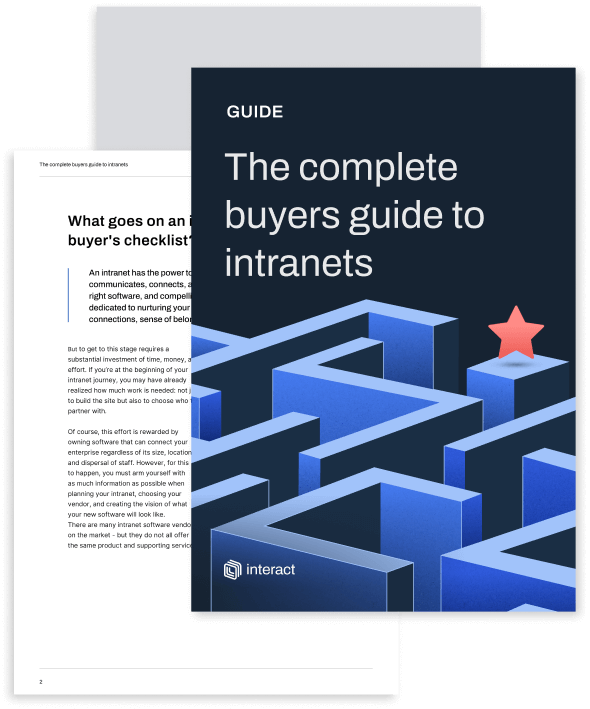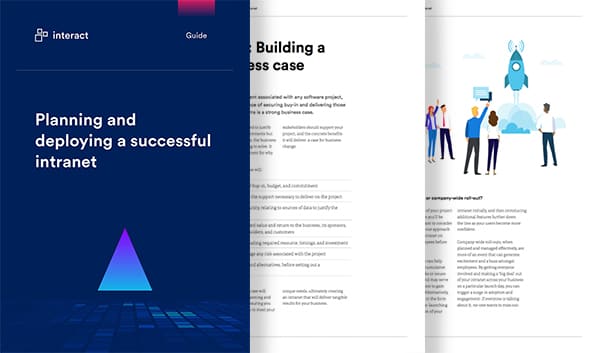What is an intranet? Historically, they have been defined as private enterprise networks: a single “private” point of access to communications, information, and software. As our digital workplaces evolve, however, the line between internal and external communication has thinned, resulting in changes in how companies use extranets and public-facing intranet content.
In 2021, the term “mixternal comms” entered our collective vocabulary. With the pandemic causing changes in our ways of working, some eagle-eyed observers of internal communications spotted that not only was work itself more frequently in the headlines, but that the ways organizations communicate with their employees were suddenly of great interest to the public.
The crystallization of a new comms paradigm
With the world looking closely at how companies spoke to and treated workers adjusting to new realities, internal communication took on an external dimension. They became mixternal. Looking back now on the intervening period of high-profile leaks, hacks, whistleblowing, and company statements, it’s clear that the trend has taken root.
The pandemic isn’t the only change behind the rise of mixternal comms, however. Companies have grown bigger and more powerful—some have annual profits that equal the GDP of small nations. Then there’s also the emergence of corporate social responsibility and a class of conscious consumers and workers (led by ethically committed Millennials and Gen Z). It is unsurprising that the biggest organizations are regularly scrutinized.
This all means that people are interested in what goes on in private organizations, so how companies communicate with employees is more important. A company’s brand no longer rests solely on its advertising or products, but also derives from a constellation of touchpoints such as employee tweets and Glassdoor reviews.
All of this is important context for internal communicators as they go about creating sensitive DE&I messages or change communications. They are more aware that their work may end up in the public domain, which may alter the tone and delivery.
Beyond the crafting of individual messages though, some communicators are considering why and how to use extranets and public-facing intranet content to support the point where their internal brand goes external.
This is an exciting thing about intranet software. A modern communications platform can be adapted for mixternal uses and can make intranet content public in a way that enables organizations to use extranets for more than connecting with commercial partners. This article suggests it could be time to consider extranets and externally facing content as part of your internal comms strategy.
The complete buyer’s guide to intranets
How do companies use extranets?
External-facing and extranet content can be helpful in a wide range of scenarios. First, it can be a simple way for internal communicators and teams to publish information, and an efficient method to contact customers, partners, or the supply chain.
💡 If you suddenly find yourself asking, “what is an extranet?” take a look at our primer on Intranet vs Extranet definitions 💡
With access to a CMS intranet, internal publishers can create branded, standardized online pages without having to go through a paper-based process or adjust a corporate website. Traditional methods such as these, involving PDFs, HTML, or similar, cause an internal bottleneck for multiple teams such as HR, IT, web developers, or marketing—anyone in charge of communication or the website content.
With a CMS though, you can use extranet pages to create public content alongside your internal communications strategy. The internal comms team can write, create, and upload public-facing pages in a streamlined way that doesn’t require input from multiple specialists.
Using the intranet to share potentially mixternal information also keeps control of the messaging and content within the internal comms team. This means that content is created by experts who understand how to communicate and know the lie of the land with senior leaders and employees alike.
From a security perspective, the same intranet admins can grant public-facing access but restrict sensitive information such as employee data, confidential workplace developments, or new features.
Given the security concern, keeping this information contained securely within your intranet software is essential. There are multiple ways that an intranet manager can use extranets and external-facing pages to achieve this, such as by giving access to designated areas based on permissions or republishing public intranet content with confidential data removed.
The benefit of using your intranet for this process is that no external pages will necessarily need to be built or configured. External-facing content can be based on existing intranet pages: created by internal teams and either republished or published with security measures to prevent full access for external users. So, if there are a few pages that you need to post mixternally, using your intranet can be effective.
Why would I need external-facing webpages?
Making intranet content accessible outside of an organization depends on the business and its industry. Some sectors are more focused on intranet vs extranet usage than others—three of the most common are below.
The complete buyer’s guide to intranets
Finance
The financial industry is fast-paced and constantly evolving. New regulations come in: others are discarded. Depending on the nature of the organization, there will be occasions when external contacts such as suppliers, partners, and investors need to access specific external documentation. In this instance, policies, external company contacts, or terms and conditions could be made available without giving them full login privileges reserved for employees only.

In such situations, the intranet can be leveraged and company resources don’t end up stretched by the need to recreate a large amount of company content.
The finance industry is highly regulated with legal data protection requirements. Enhanced security provided by using closed-off pages within intranet software is one way to ensure that no one gets access to a restricted part of the intranet, but they still have the required information.
Education
From early years childcare settings to university life, the education sector requires externally facing webpages. Whilst communicating with their internal teams is essential for a thriving workplace culture, interacting with parents or students and keeping them informed of upcoming news is also key.
For an institution such as Manchester Metropolitan University, when choosing an intranet, they understood that it must have features including the ability to post on external webpages, or they would be missing out on an important piece of their communications strategy.
When choosing intranet software, their requirements were precise:
“First, the need to improve sharing and access to news and updates from the University. The next requirement was around findability of main policies, procedures and important documents; and finally, to provide an enhanced staff directory that could include photos and additional information, beyond just telephone number and job title.”
Many educational institutions use extranets to some degree, so the need to stay competitive and offer their students the best experience was apparent. Using external webpages in this way allowed Manchester Metropolitan University to extend some internal communications and documentation to select people outside of their employment, keeping students informed and updated.
Healthcare
Healthcare organizations deal with sensitive data daily, and they also deal with numerous external entities that may require access to certain information. This could include external agencies, government departments, pharmaceutical companies, patients, research institutes, etc.
Depending on the institution, patients may also use extranets and externally-facing intranet pages to access medical records or results. External users will sometimes need access to documentation and leaving it to be produced manually or sent out individually puts pressure on internal teams.
It is much simpler to store all required internal information on webpages. This searchable knowledge repository is only available to a select few and does not allow access to the complete employee intranet. That way, the information is ready 24/7 as required, and the healthcare institution is confident that the external source has accessed nothing sensitive.

This streamlines the process for already stretched healthcare professionals and removes the pressure from IT and internal sources, as the information is provided as required instead of via multiple ad hoc requests. Improving operations in this way centralizes information and streamlines UX for a range of readers with different levels of technological ability.
Use extranets and content in your mixternal workplace
Intranets are designed to improve communication within the workplace. When used alongside externally-facing pages though, they can also provide an effective means for distributing company information to bridge the internal-external divide. If done correctly, an intranet can offer secure access to external resources that many business contacts and customers may need.
Depending on the needs and requirements of an organization, this can answer the headache of how to create a mixternal strategy that blends the private and the public.


